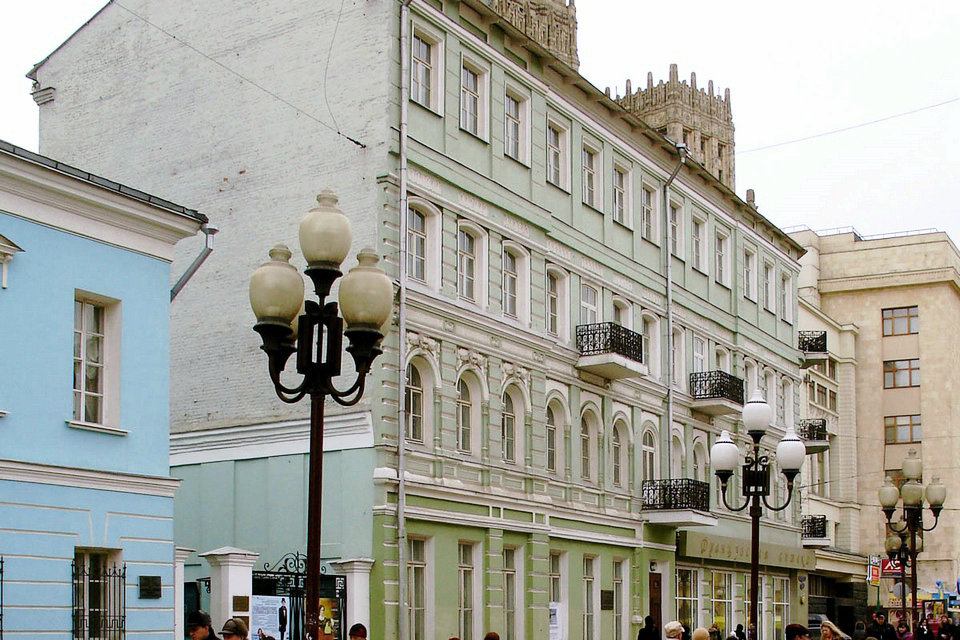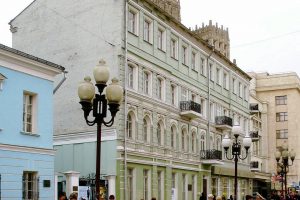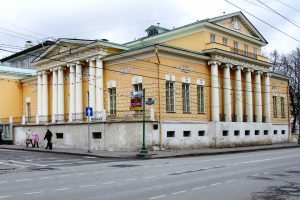Museum-apartment of Andrei Bely – a memorial apartment dedicated to the life and work of writer Boris Bugaev, known under the pseudonym Andrei Bely. Branch of the State Museum of A.S. Pushkin. The Bely Museum-apartment was founded in 1993, however, the official opening of the exposition took place in September 2000. In the house on the corner of the Arbat and Money Lane, Bely lived the first twenty-six years of his life from 1880 to 1906. At the beginning of 2018, the exposition has more than four thousand memorial items: family photographs, manuscripts of works, personal items, drawings.
“Andrei Bely Memorial Apartment” is the only museum in the world dedicated to Andrei Bely (real name is Boris Nikolaevich Bugaev; 1880-1934), poet, writer, philosopher, theorist of symbolism and the anthroposophist-mystic. The museum provides its visitors with the opportunity to plunge into the atmosphere of the first third of the twentieth century, to get acquainted with the biography and work of one of the most prominent representatives of the Silver Age.
The museum is located in house number 55 on the corner of Arbat and Money Lane, in an apartment on the third floor. Andrey Bely was born in this apartment. Associated with her are his first distinct “twinkles of consciousness,” childhood memories of the world, people, and himself. Here he spent years of his studies – at the famous private gymnasium of Lev Polivanov on Prechistenka, then – at Moscow University. Here he experienced the first excitement of passion and comprehended the grief of loss – the death of his father. Here, from Borya Bugaev, a boy from a professorial family, a modernist writer, the leader of Moscow Symbolists, Andrey Bely, was formed. He lived in this apartment for twenty-six years – from birth to 1906.
Then, in the biography of Bely, there were many addresses, cities, countries: he rented rooms in different parts of Moscow and in the village of Kuchino near Moscow, in St. Petersburg and in Tsarskoye Selo, in the Swiss town of Dornach and in Berlin… But he considered Arbat his homeland, and his real home – the one in which the museum is now.
History
Museum-apartment of Andrei Bely is located on the third floor of the house at the corner of Arbat and Money Lane. The dean of the Faculty of Physics and Mathematics of Moscow University Nikolai Bugaev and his wife Alexandra Egorova rented an apartment from the second half of the 1870s, and it was here in 1880 that their son Boris was born. Famous guests were often visited by guests: Maxim Kovalevsky, Nikolai Storozhenko, Alexander Veselovsky, brothers Sergey and Vladimir Taneyev, Leo Tolstoy and others.
From the beginning of the 1900s, a circle of “Argonauts” was gathering in Andrei Bely’s apartment on Arbat, the head of which was a writer. There were poets Konstantin Balmont, Jurgis Baltrushaitis, Valery Bryusov and Maximilian Voloshin, artists Victor Borisov-Musatovi Mikhail Shesterkin, as well as many others. Zinaida Gippius, Dmitry Merezhkovsky, Vyacheslav Ivanov, Alexander Blok came to attend one of the meetings from St. Petersburg. In 1906, Bely and his mother rented an apartment in Nikolsky Lanefather died three years earlier. Subsequently, the writer lived in other places in Moscow, in the village of Kuchino, St. Petersburg, Dornach and Berlin. In memoirs and autobiographical prose, for example, “The Baptized Chinese” and “Kotik Letaev,” Bely described his apartment in detail on Arbat .
“I got out of the nursery – into the apartment, and found the environment in it; there was a line between our apartment, Arbat, Moscow, then Russia and the children’s room, because the apartment is already a circle of apartments subject to a single rule; we can say that my perception of the apartment in infancy is double any.
The apartment is first broken to me; Actually: I know a nursery; everything is familiar in it, not scary; she is the house; the same as behind the wall, there is no longer a house, because the living room with windows to the world, on Arbat, is the same as this world, or Arbat, from which one or another appears to us with the rules; and dad and mom are closely connected with these semi-famous personalities, and to me these personalities are often completely unknown, very suspicious.
Building
Andrei Bely’s apartment is located in a former apartment building owned by noblewoman M.I. Khromova. In 1876, the mansion that stood on this site was completely rebuilt by the architect Mitrofan Arsenyev, after which there were retail premises on the ground floor, and the second and third occupied apartments for rent. After the repair was completed, Khromova sold the house to Privatdocent of the Moscow Imperial University N.I. Rakhmanov. Apartments in the house were rented to university employees: statistics specialist Ivan Yanzhul lived here, and Mikhail Solovyov, the brother of the philosopher Vladimir Solovyov and the father of the poet Sergei Solovyov, rented housing on the floor belowwith whom Andrei Bely made friends .
Andrei Bely’s apartment consisted of a front, a kitchen and five living rooms. The ceremonial rooms overlooked Money Lane, the living room was overlooking old Moscow. Sitting on the balcony in the living room, the writer created the work “Symphony (2nd, dramatic)”, which brought him fame. From the living room one could get into the small nursery, the parents’ bedroom and the father’s office, which later became the office of Andrei Bely .
In 1930, the house housed communal apartments, and since 1970 the building was transferred to the Ministry of Foreign Affairs. In the 1980s, the former apartment of the Bugaev family became part of the Alexander Pushkin State Museum, the memorial apartment of which is located in the neighboring building.
Museum opening
The first seven years from the date of opening, the museum functioned as an exhibition space, while the employees of the institution collected the memorial collection. The museum was officially opened in September 2000 .
Museum funds were formed largely due to gifts. Most of the collection is occupied by the materials of Tatyana Norina, before her death, the second wife of Andrei Bely handed over the property of the family: memorial furniture, personal belongings of the writer, letters, photographs and other materials. The museum funds contain archives of the first wife of Belyi Asya Turgeneva and his literary secretary P.N. Zaitsev. The museum received a large archive from the literary secretary of the writer Pyotr Zaitsev, who had been working for Bely since 1932. Zaitsev’s collection included autographed books by the writer, as well as the original poem by Osip Mandelstam, written on the day of Andrei Bely’s funeral.
Politician Fedor Golovin donated to the museum an album of drawings in which Andrei Bely is depicted in a satirical manner. In several drawings, the writer sits at the table with Dmitry Shakhovsky, a member of the cadet party, and debates in others.
Valentina Rykova handed over to the museum the archive of the writer’s first wife. It contained documents about the friends and colleagues of Andrei Bely – the poets Sergei Spassky and Vladimir Piast, as well as the sculptor Sonya Kaplun. In addition, the museum acquired part of the archive of A. Polyakova, the daughter of a scientist who examined the writer’s brain after his death. At the opening ceremony of the museum in 2000, the Russian Ministry of Foreign Affairs announced the transfer to the institution of a photograph of Andrei Bely and a copy of the permission to enter from Switzerland to Russia, issued in 1916 to Boris Bugaev for military duty.
Exposition
At the beginning of 2018, the museum’s collection includes several thousand memorial items. In the formation of the museum space, the organizers sought to reflect both the biography and the ideological development of Bely’s work .
The exhibition begins with a hallway, in which are the personal suitcases of the writer, with whom he traveled to Russia, Germany and Switzerland. The exhibition continues in the children’s room, in the corner of which stands a showcase with a changing envelope by Andrei Bely donated to the museum by a distant relative, as well as family photographs . The subjects presented in the nursery tell about Bely’s studies at the gymnasium of Lev Polivanov and, later, at the natural department of the Physics and Mathematics Faculty of Moscow State University. There are gymnasium textbooks, certificate of nobility upon admission to the university. This room contains materials related to the first autobiographical work – the story “Kotik Letaev”: drawings, materials about the construction of the Goetheanum and the relationship of Bely with his first wife, whom the story is dedicated to.
The next room belonged to the mother of the writer Alexandra Bugaeva. Here is stored her photo album with images of the artist Leo Bakst, as well as the first collection of poems of the writer “Gold in Lazur” dedicated to her mother. The original furniture was not preserved, and the museum staff decided to replace it with a similar one of the same time period. In the room hangs a portrait of the first lover of White Margarita Morozova, the work of artist Viktor Shtember .
In the office of Nikolai Bugaev is a professor’s desk and materials related to friends and famous guests. In another part of the room, materials are presented about the life of Andrei Bely in the village of Kuchino near Moscow and the materials of his work on the novel “Moscow”, the prototype of the protagonist of which was the father of the writer. Many memorial items were stored in France for a long time: the second wife of the writer Claudius handed over a suitcase with personal belongings to his godson Andrei Bogoslovsky, who, in turn, transferred them to the French embassy for storage. Only in 2010, memorial items were included in the museum’s collection .
The next hall of the exposition is the dining room. Here are the personal belongings of the writer, as well as the original poem by Osip Mandelstam, written on the day of the death of Andrei Bely. The central exhibit is the autobiographical scheme Life Line .
The last room of the exposition is the Living Room, which previously gathered a circle of “Argonauts” and hosted numerous guests of the family. At the beginning of 2018, the museum uses the living room as an exhibition hall for conferences and musical evenings .
State A.S.Pushkin Museum
State Museum A.S. Pushkin today is one of the recognized cultural centers of Moscow and Russia. In addition to the main museum, the GMP includes five more branches: A.S. Memorial Apartment Pushkin on the Arbat, A. Bely Memorial Apartment on the Arbat, I.S. House Museum Turgenev on Ostozhenka, House Museum of V.L. Pushkin on Old Basmannaya and Exhibition Halls in Denezhny Lane. The main museum complex is located in a wonderful architectural monument of the beginning of the 19th century – the city noble estate of the Khrushchev-Seleznev on ul. Prechistenka, 12/2.
The historical mansion houses permanent expositions “Pushkin and his era” and “Pushkin’s Tales”, exhibition halls, a reading room, concert and conference halls. Here, on Prechistenka, there are funds of the museum with open storage of rare books, paintings, graphic and miniature portraits of the 18th-19th centuries, porcelain, bronze, art glass and ceramics, genealogical materials. The GMP Open Storage includes unique private collections donated to the Moscow Museum of A.S. Pushkin – “Library of Russian poetry of I.N. Rozanov”, “P.V. Collection Gubara “,” Cabinet T.A. Mavrina and N.V. Kuzmina ”,“ Cabinet of drawings by Nadia Rusheva ”. The Atrium is intended for large-scale cultural events – a manor courtyard covered with a glass dome, combining the museum complex in a single space in 1999, to mark the 200th anniversary of A.S. Pushkin.
Museum town
Museum Town – a project to expand the Pushkin Museum, dedicated to the centenary of the opening of the Pushkin Museum. In 2008, the museum management announced the first competition for the design of the museum quarter, in which the bureau of British architect Norman Foster won. According to the plan presented, the town was supposed to stretch from the Kropotkinskaya metro station to Borovitskaya square, part of the streets would become pedestrian, and on the territory of the Golitsyn estate and the Kremlin gas stationwould build a glass exhibition “five leaf”. Since the project involved the demolition of some historical buildings, the bureau presented in 2012 an updated project. However, a year later, Foster refused to participate in the project.
In the second architectural competition announced in 2014, the Rhizosphere program was won by the Meganom Bureau, which is led by Yuri Grigoryan. According to the plan, nine museums, an exhibition hall, a depository, a depository, as well as public areas will be created in the town. According to the plan, the area of the cultural cluster should be 105,000 m². Initially, the construction was planned to be completed by 2023, but in July 2019 it became known about a two-year shift in the timing of reconstruction .




